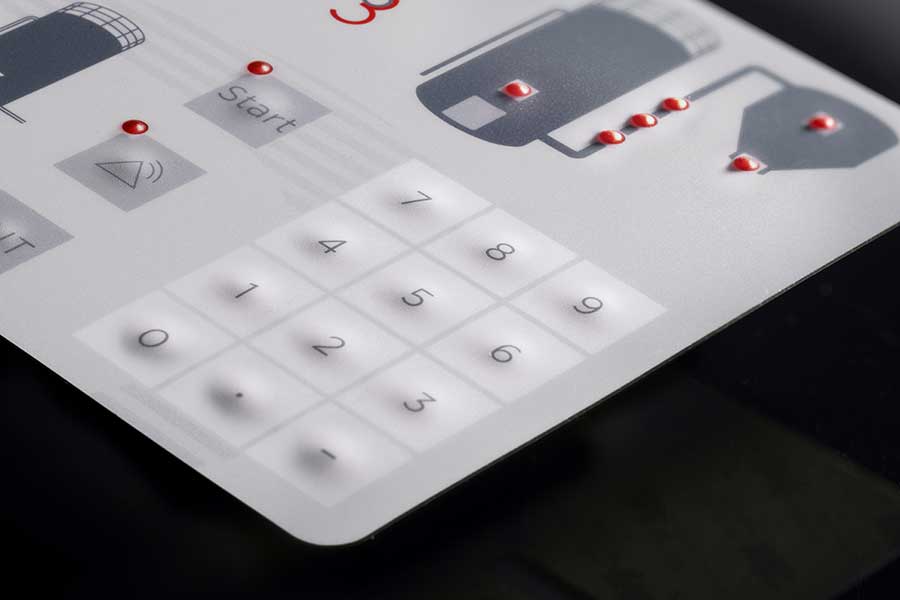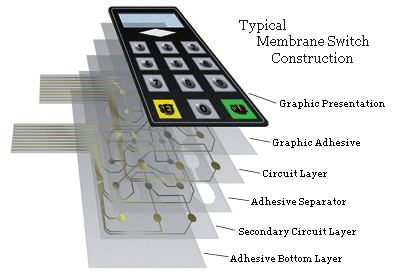Teaming up with an experienced membrane switch manufacturer enhances your production process.
Teaming up with an experienced membrane switch manufacturer enhances your production process.
Blog Article
All Concerning Membrane Layer Switch Over: Understanding Its Layout and Performance
When you think of the control interfaces in modern-day devices, membrane layer switches frequently enter your mind. These parts are greater than simply buttons; they blend design and capability effortlessly. Comprehending how they function and what makes them efficient can transform your perspective on day-to-day electronic devices. There are subtleties to their style and efficiency that you could not be conscious of. Allow's explore what sets membrane switches over besides other control systems.
What Are Membrane Layer Switches?

Their seamless nature makes them very easy to tidy and immune to dust and wetness, a crucial function in numerous atmospheres. Membrane layer switches can likewise be customized relating to form, dimension, and graphics, permitting producers to produce one-of-a-kind interfaces tailored to specific items. Plus, they're light-weight and thin, which helps in decreasing the overall bulk of gadgets. In general, membrane layer switches play a significant function in boosting customer experience throughout a broad selection of applications.
How Membrane Switches Job
When you press a trick on a membrane button, it triggers an uncomplicated yet efficient device. membrane switch manufacturer. The top layer, often made of versatile product, pushes down onto a conductive layer beneath it.
You'll observe that the tactile responses differs based on the button layout, using either a soft click or an extra noticable feedback. Once you release the secret, the membrane layer go back to its original setting, reopening the circuit and quiting the signal. This process occurs practically instantly, making sure a receptive customer experience.
Membrane buttons are prominent due to their sturdiness and resistance to dust and wetness, making them excellent for various applications, from house devices to clinical tools. Recognizing this procedure helps you value their widespread use.
Trick Elements of Membrane Layer Switches
Recognizing the vital elements of membrane layer switches is basic for comprehending their functionality and design. The protective layer shields versus environmental factors and put on, extending the button's lifespan. By understanding these parts, you'll acquire understanding right into how membrane layer changes run and their relevance in various applications.
Materials Used in Membrane Change Layout
The performance and resilience of membrane switches greatly rely on the materials made use of in their design. You typically encounter polyester and polycarbonate as primary substratums because of their exceptional toughness and flexibility. These products resist scrapes and chemicals, making them excellent for requiring settings.
The conductive layers usually make use of silver or carbon, chosen for their integrity and conductivity. membrane switch manufacturer. Silver gives remarkable efficiency, while carbon is an affordable choice. For the overlay, you could take into consideration a matte or shiny finish, depending on your visual needs and individual experience
Make certain to select adhesives that withstand environmental factors like temperature and moisture. Selecting the best materials will guarantee your membrane button stands the examination of time.
Style Factors To Consider for Membrane Layer Buttons
While making membrane layer switches, it's vital to think about various factors that affect their performance and user experience. Beginning by concentrating on the format and button size; ensure they're intuitive and easy to browse. Take into consideration the tactile responses you want to supply-- will users require a noticeable click or a softer touch? In addition, consider the products you'll utilize, as they'll impact longevity and appearances.
Do not overlook the graphic style; clear labeling and color contrast are considerable for exposure. Validate your layout accommodates ecological variables, like dampness or temperature variations, which can influence efficiency. Lastly, remember the value of screening prototypes with real users to collect feedback and make required changes. This iterative procedure helps you refine the style, verifying it satisfies both useful and visual demands successfully. By thoroughly thinking about these elements, you'll develop a membrane button that boosts functionality and contentment.
Applications of Membrane Buttons
Membrane layer buttons are versatile elements found in various applications, from industrial equipment to customer electronic devices. You'll see their effect in makers that call for long lasting user interfaces and in gadgets that benefit from sleek designs. Recognizing these applications aids you value the capability and functionality of membrane buttons in everyday modern technology.
Industrial Devices Use
When you're wanting to enhance the capability of industrial tools, membrane switches provide a trusted remedy that integrates sturdiness with straightforward layout. These buttons are ideal for harsh settings, providing resistance to dirt, wetness, and chemicals. You'll find them in control panels for manufacturing makers, heating and cooling systems, and medical gadgets, where precision and responsiveness are essential. Their reduced account implies they fit flawlessly into numerous devices, conserving valuable area while keeping ease of usage. you could look here With customizable graphics and backlighting options, you can develop an intuitive interface for drivers, enhancing performance and safety. And also, their lengthy lifespan reduces upkeep expenses, making them a wise investment for your industrial applications. Embrace membrane switches to simplify your operations and enhance overall performance.
Consumer Electronics Integration
In the domain of consumer electronics, membrane switches play an important function in improving customer communication and gadget performance. You'll locate them in devices like microwaves, push-button controls, and video web link gaming consoles, offering a smooth method to interact with technology. Their streamlined layout enables simple assimilation right into different products, making controls user-friendly and user-friendly. With their capacity to include graphics and backlighting, you can take pleasure in a modern-day aesthetic that matches the device's general look. Membrane buttons additionally ensure toughness and resistance to dirt and dampness, expanding the life-span of your electronics. By picking membrane layer buttons, you improve not just the functionality but also the style of your devices, making daily communications smooth and satisfying.
Advantages and Negative Aspects of Membrane Buttons
While membrane layer buttons offer a variety of benefits, they additionally come with some downsides that you should consider. One considerable advantage is their portable style, making them suitable for space-constrained applications.

Membrane layer buttons can have a shorter lifespan contrasted to mechanical switches, especially under heavy use. They can likewise be less tactile, which might affect customer comments throughout operation. Stabilizing these pros and cons will assist you figure out if membrane layer switches are the ideal fit for your job.
Frequently Asked Inquiries
How Much Time Do Membrane Layer Changes Usually Last?
Membrane layer changes typically last between 5 to ten years, depending upon use and environmental conditions. You'll want to review elements like wear, direct exposure to moisture, and temperature fluctuations to gauge their durability successfully.
Can Membrane Switches Be Custom-made for Specific Designs?
Yes, you can tailor membrane layer buttons to fit certain styles (membrane switch manufacturer). You'll have the freedom to pick colors, forms, and layouts that match your job's check out this site needs, ensuring they blend effortlessly with your overall aesthetic
What Is the Expense Range for Membrane Switch Over Manufacturing?
The price range for membrane button production typically drops between $1 and $10 per system, depending on elements like design intricacy, amount, and materials. You can get quotes from makers to discover the ideal alternative.

Are Membrane Layer Switches Water-proof or Immune?
Membrane layer buttons can be designed to be water resistant or immune, depending on products utilized and construction methods. If you need them for wet atmospheres, ensure you specify those demands during the layout process.
Exactly How Do Membrane Layer Changes Compare to Typical Buttons?
Membrane switches are usually thinner and extra adaptable than typical switches, providing a sleek design. They're frequently simpler to clean and integrate, yet may not supply the responsive comments you're used to with mechanical options.
Verdict

Report this page